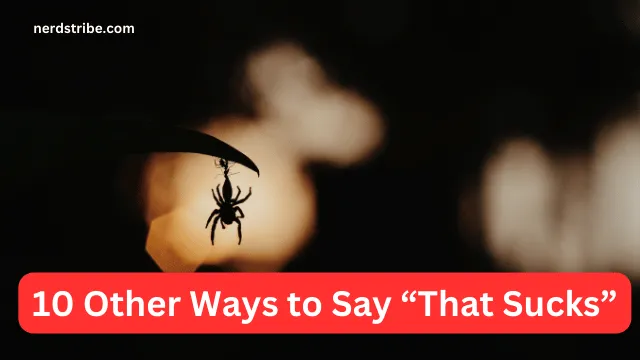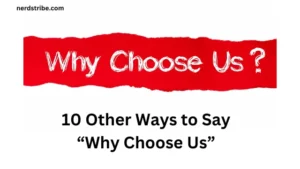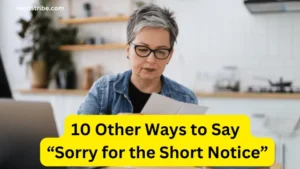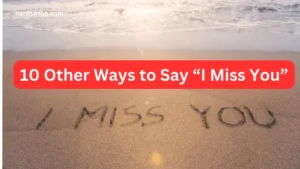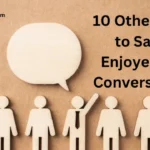Hook: We’ve all been there—something goes wrong, and your first instinct is to say, “That sucks.” While it gets the point across, sometimes you need a phrase that better captures the intensity or nuance of the situation.
In this post, we’re going to explore 10 alternative ways to express your disappointment or frustration, helping you sound more thoughtful and varied in your everyday conversations.
Thesis Statement: Though “that sucks” is universally understood, using a range of alternatives can deepen your emotional expression and elevate your vocabulary. In the process, you’ll be able to convey specific feelings more accurately and avoid sounding repetitive.
Overview: From casual moments of annoyance to more formal expressions of regret, this article will guide you through 10 different ways to express that something is “not good.” Whether you’re feeling let down, frustrated, or just a bit sad, these alternatives will add flavor and variety to your language.

Contents
- 1 1. “That’s a bummer”
- 2 2. “What a drag”
- 3 3. “That’s a shame”
- 4 4. “That’s too bad”
- 5 5. “What a pity”
- 6 6. “That’s unfortunate”
- 7 7. “Bummer”
- 8 8. “Disappointing”
- 9 9. “Awful”
- 10 10. “Dreadful”
- 11 Conclusion
- 12 FAQs
- 12.1 Why should I use alternatives to “That sucks”?
- 12.2 Can these phrases be used in formal settings?
- 12.3 Which expression is the least intense?
- 12.4 How do I decide which phrase to use?
- 12.5 Are these phrases commonly used in everyday conversations?
- 12.6 Can I combine these phrases for greater effect?
1. “That’s a bummer”
- Focus: Casual, informal expression of disappointment.
- Example: “I can’t believe I missed the concert. That’s a bummer.”
- Nuance: Implies light frustration without being too harsh or serious.
2. “What a drag”
- Focus: Informal, emphasizes annoyance or something tedious.
- Example: “It’s such a drag to have to cancel plans.”
- Nuance: Indicates something that feels boring or frustrating rather than just disappointing.
3. “That’s a shame”
- Focus: More formal, used to express sympathy.
- Example: “That’s a shame that you missed out on the sale.”
- Nuance: Conveys genuine sympathy and regret for someone else’s misfortune.
4. “That’s too bad”
- Focus: Casual, expressing disappointment in a neutral tone.
- Example: “That’s too bad you didn’t get the job you wanted.”
- Nuance: Less emotionally intense than other phrases, but still conveys disappointment.
5. “What a pity”
- Focus: Formal, often used for missed opportunities.
- Example: “What a pity the event was canceled last minute.”
- Nuance: Conveys a sense of loss or regret with a slightly more dramatic undertone.

6. “That’s unfortunate”
- Focus: Formal and polite expression of disappointment.
- Example: “It’s unfortunate that the flight was delayed.”
- Nuance: A neutral way to acknowledge a setback without showing strong emotion.
7. “Bummer”
- Focus: Informal, short version of “that’s a bummer.”
- Example: “Forgot my umbrella—bummer!”
- Nuance: A quick, casual way to show mild disappointment.
8. “Disappointing”
- Focus: Direct, straightforward expression of dissatisfaction.
- Example: “The movie was disappointing, I expected more.”
- Nuance: Objective and factual, ideal when stating clear dissatisfaction.
9. “Awful”
- Focus: Stronger, more intense expression of dislike or disapproval.
- Example: “The weather today is awful.”
- Nuance: Suggests a strong negative reaction to something unpleasant.
10. “Dreadful”
- Focus: Formal and strong disapproval.
- Example: “The service was dreadful at the new restaurant.”
- Nuance: Conveys a severe level of disappointment, often used for major letdowns.
Conclusion
Expanding your vocabulary beyond “That sucks” opens up new ways to express yourself more thoughtfully. Whether you want to convey mild disappointment or serious frustration, the 10 alternatives we’ve covered offer a range of expressions suited for every situation.
By experimenting with these phrases, you’ll be able to communicate more effectively, adding richness and variety to your conversations.
Note: Always choose the phrase that best matches the context and your relationship with the person you’re speaking to. This will ensure your language feels both natural and fitting.
Enhancing your vocabulary doesn’t just improve your communication—it helps you express your feelings more precisely and make your conversations more engaging.
FAQs
Why should I use alternatives to “That sucks”?
Using alternatives adds variety and helps you express nuanced emotions more accurately, whether you’re disappointed, frustrated, or just annoyed.
Can these phrases be used in formal settings?
Some phrases like “That’s a shame” or “That’s unfortunate” are perfectly appropriate for formal settings, while others like “Bummer” are better suited for casual conversations.
Which expression is the least intense?
Phrases like “That’s too bad” or “That’s a shame” are less intense and convey sympathy without expressing strong negativity.
How do I decide which phrase to use?
Choose the phrase based on the level of intensity you want to convey and the tone of the conversation. Formal settings call for more polite expressions like “That’s unfortunate,” while informal settings can use casual terms like “Bummer.”
Are these phrases commonly used in everyday conversations?
Yes, these alternatives are commonly used, but the choice of phrase may vary depending on the context and audience.
Can I combine these phrases for greater effect?
Certainly! Combining phrases like “What a pity” and “That’s unfortunate” can create a stronger expression of regret or frustration. Just make sure not to overuse them.

